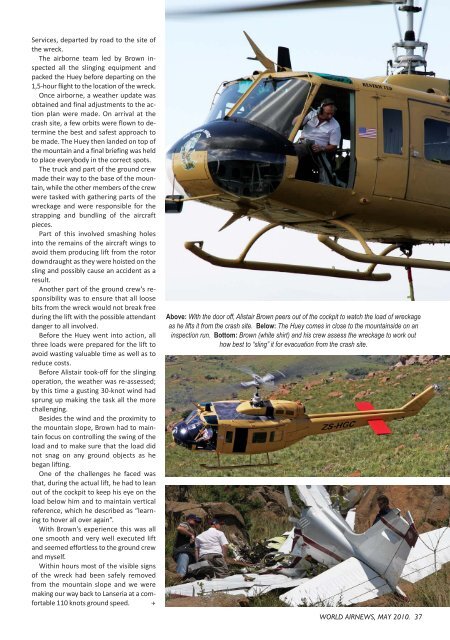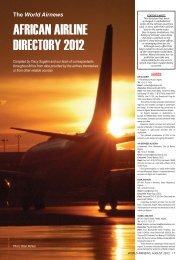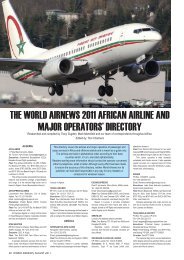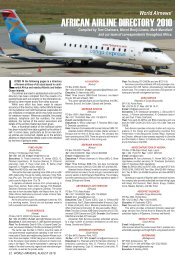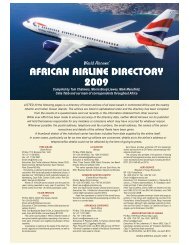May 2010 covers_Covers.qxd - World Airnews
May 2010 covers_Covers.qxd - World Airnews
May 2010 covers_Covers.qxd - World Airnews
You also want an ePaper? Increase the reach of your titles
YUMPU automatically turns print PDFs into web optimized ePapers that Google loves.
Services, departed by road to the site of<br />
the wreck.<br />
The airborne team led by Brown inspected<br />
all the slinging equipment and<br />
packed the Huey before departing on the<br />
1,5-hour flight to the location of the wreck.<br />
Once airborne, a weather update was<br />
obtained and final adjustments to the action<br />
plan were made. On arrival at the<br />
crash site, a few orbits were flown to determine<br />
the best and safest approach to<br />
be made. The Huey then landed on top of<br />
the mountain and a final briefing was held<br />
to place everybody in the correct spots.<br />
The truck and part of the ground crew<br />
made their way to the base of the mountain,<br />
while the other members of the crew<br />
were tasked with gathering parts of the<br />
wreckage and were responsible for the<br />
strapping and bundling of the aircraft<br />
pieces.<br />
Part of this involved smashing holes<br />
into the remains of the aircraft wings to<br />
avoid them producing lift from the rotor<br />
downdraught as they were hoisted on the<br />
sling and possibly cause an accident as a<br />
result.<br />
Another part of the ground crew’s responsibility<br />
was to ensure that all loose<br />
bits from the wreck would not break free<br />
during the lift with the possible attendant<br />
danger to all involved.<br />
Before the Huey went into action, all<br />
three loads were prepared for the lift to<br />
avoid wasting valuable time as well as to<br />
reduce costs.<br />
Before Alistair took-off for the slinging<br />
operation, the weather was re-assessed;<br />
by this time a gusting 30-knot wind had<br />
sprung up making the task all the more<br />
challenging.<br />
Besides the wind and the proximity to<br />
the mountain slope, Brown had to maintain<br />
focus on controlling the swing of the<br />
load and to make sure that the load did<br />
not snag on any ground objects as he<br />
began lifting.<br />
One of the challenges he faced was<br />
that, during the actual lift, he had to lean<br />
out of the cockpit to keep his eye on the<br />
load below him and to maintain vertical<br />
reference, which he described as “learning<br />
to hover all over again”.<br />
With Brown’s experience this was all<br />
one smooth and very well executed lift<br />
and seemed effortless to the ground crew<br />
and myself.<br />
Within hours most of the visible signs<br />
of the wreck had been safely removed<br />
from the mountain slope and we were<br />
making our way back to Lanseria at a comfortable<br />
110 knots ground speed. Q<br />
Above: With the door off, Alistair Brown peers out of the cockpit to watch the load of wreckage<br />
as he lifts it from the crash site. Below: The Huey comes in close to the mountainside on an<br />
inspection run. Bottom: Brown (white shirt) and his crew assess the wreckage to work out<br />
how best to “sling” it for evacuation from the crash site.<br />
WORLD AIRNEWS, MAY <strong>2010</strong>. 37


